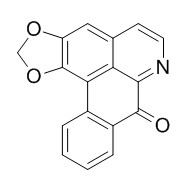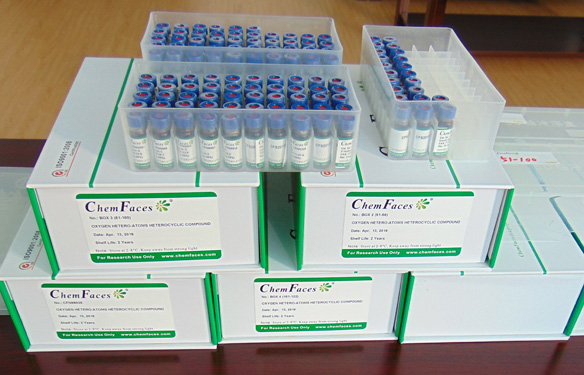Liriodenine
Liriodenine is a potent inhibitor of topoisomerase II (EC 5.99.1.3) both in vivo and in vitro, it has antitumor, antibacterial and antifungal activities, it can suppress ventricular arrhythmias induced by myocardial ischaemia reperfusion, through inhibition of Na+ and the Ito channel. Liriodenine also has antimuscarinic properties, the antimuscarinic characteristics are similar to those of 4-diphenylacetoxy-N-methylpiperidine (4-DAMP, smooth muscle selective M3 antagonist), it may act as a selective M3 receptor antagonist in canine tracheal smooth muscle.
Inquire / Order:
manager@chemfaces.com
Technical Inquiries:
service@chemfaces.com
Tel:
+86-27-84237783
Fax:
+86-27-84254680
Address:
1 Building, No. 83, CheCheng Rd., Wuhan Economic and Technological Development Zone, Wuhan, Hubei 430056, PRC
Providing storage is as stated on the product vial and the vial is kept tightly sealed, the product can be stored for up to
24 months(2-8C).
Wherever possible, you should prepare and use solutions on the same day. However, if you need to make up stock solutions in advance, we recommend that you store the solution as aliquots in tightly sealed vials at -20C. Generally, these will be useable for up to two weeks. Before use, and prior to opening the vial we recommend that you allow your product to equilibrate to room temperature for at least 1 hour.
Need more advice on solubility, usage and handling? Please email to: service@chemfaces.com
The packaging of the product may have turned upside down during transportation, resulting in the natural compounds adhering to the neck or cap of the vial. take the vial out of its packaging and gently shake to let the compounds fall to the bottom of the vial. for liquid products, centrifuge at 200-500 RPM to gather the liquid at the bottom of the vial. try to avoid loss or contamination during handling.
Environ Toxicol.2024, 39(4):2417-2428.
Front Plant Sci.2021, 12:673337.
Front Microbiol.2021, 12:736780.
J Agric Food Chem.2018, 66(1):351-358
Int Immunopharmacol.2021, 100:108073.
Mol Med Rep.2024, 29(2):26.
Nutrients.2021, 13(3):978.
Sci Rep.2018, 8(1):12970
J Appl Biol Chem.2024, 67:47,337-343.
Int J Mol Sci.2024, 25(17):9730.
Related and Featured Products
Oncol Lett. 2015 Mar;9(3):1121-1127.
Liriodenine induces the apoptosis of human laryngocarcinoma cells via the upregulation of p53 expression.[Pubmed:
25663867]
Liriodenine, an alkaloid extracted from a number of plant species, has demonstrated antitumor effects on multiple types of cancer. However, the effects of Liriodenine upon laryngocarcinoma, and the underlying mechanisms, are yet to be elucidated.
METHODS AND RESULTS:
The present study therefore investigated the potential antitumor effects of Liriodenine on HEp-2 human laryngocarcinoma cells in vitro and HEp-2-implanted nude mice in vivo. Liriodenine induced significant apoptosis and inhibition of cell migration in the HEp-2 cells. Furthermore, the rate of tumor growth in the HEp-2-implanted nude mice was inhibited by the administration of Liriodenine. The potential mechanism underlying the antitumor effects of Liriodenine may result from an upregulative effect upon p53 expression, which ultimately induces cellular apoptosis. By contrast, the downregulation of p53 significantly reduced the antitumor effects of Liriodenine.
CONCLUSIONS:
Together, these results suggest that Liriodenine exhibits potent antitumor activities in laryngocarcinoma HEp-2 cells, in vitro and in vivo, via the upregulation of p53 expression. Liriodenine may therefore be a potential therapy for the treatment of laryngocarcinoma.
Z Naturforsch C. 2011 Jul-Aug;66(7-8):377-84.
Liriodenine, early antimicrobial defence in Annona diversifolia.[Pubmed:
21950162]
Annonaceae aporphine alkaloids, of which Liriodenine is the most abundant, have not been extensively studied from a biological standpoint. The goal of this study was to investigate the role of Liriodenine in antimicrobial defense during early developmental stages in Annona diversifolia.
METHODS AND RESULTS:
The fungi Rhizopus stolonifer and Aspergillus glaucus, which are responsible for seed deterioration, were isolated during imbibition, and their antifungal activity was determined by diffusion, macrodilution, and metabolic inhibition assays using purified Liriodenine and alkaloid extracts obtained from embryos, radicles, and roots at early developmental stages. The presence of Liriodenine in extracts was quantified by high-performance liquid chromatography. Purified Liriodenine and alkaloidal extracts inhibited both fungi, and there was a positive relationship between extract activity and amount of Liriodenine contained therein.
CONCLUSIONS:
The quantity of Liriodenine present in extracts suggests its importance in controlling other phytopathogens.
Biochem Pharmacol. 1997 Aug 15;54(4):467-73.
Inhibition of topoisomerase II by liriodenine.[Pubmed:
9313773]
The cytotoxic oxoaporphine alkaloid Liriodenine, isolated from Cananga odorata, was found to be a potent inhibitor of topoisomerase II (EC 5.99.1.3) both in vivo and in vitro.
METHODS AND RESULTS:
Liriodenine treatment of SV40 (simian virus 40)-infected CV-1 cells caused highly catenated SV40 daughter chromosomes, a signature of topoisomerase II inhibition. Strong catalytic inhibition of topoisomerase II by Liriodenine was confirmed by in vitro assays with purified human topoisomerase II and kinetoplast DNA. Liriodenine also caused low-level protein-DNA cross-links to pulse-labeled SV40 chromosomes in vivo, suggesting that it may be a weak topoisomerase II poison. This was supported by the finding that Liriodenine caused topoisomerase II-DNA cross-links in an in vitro assay for topoisomerase II poisons. Verapamil did not increase either Liriodenine-induced protein-DNA cross-links or catalytic inhibition of topoisomerase II in SV40-infected cells.
CONCLUSIONS:
This indicates that Liriodenine is not a substrate for the verapamil-sensitive drug efflux pump in CV-1 cells.
Br J Pharmacol. 1994 Dec;113(4):1464-70.
Antimuscarinic action of liriodenine, isolated from Fissistigma glaucescens, in canine tracheal smooth muscle.[Pubmed:
7889303 ]
METHODS AND RESULTS:
1. The antimuscarinic properties of Liriodenine, isolated from Fissistigma glaucescens, were compared with methoctramine (cardioselective M2 antagonist) and 4-diphenylacetoxy-N-methylpiperidine (4-DAMP, smooth muscle selective M3 antagonist) by radioligand binding tests, functional tests and measurements of second messenger generation in canine cultured tracheal smooth muscle cells. 2. Liriodenine, pirenzepine, methoctramine and 4-DAMP displaced [3H]-N-methyl scopolamine ([3H]-NMS) binding in a concentration-dependent manner with Ki values of 2.2 +/- 0.4 x 10(-6), 3.3 +/- 0.7 x 10(-7), 8.9 +/- 2.3 x 10(-8) and 2.3 +/- 0.6 x 10(-9) M, respectively. The curves for competitive inhibition of [3H]-NMS with Liriodenine, methoctramine and 4-DAMP were best fitted according to a two site model of binding, but pirenzepine was best fitted according to a model with one site. 3. Liriodenine and 4-DAMP displayed a high affinity for blocking tracheal contraction (pKB = 5.9 and 9.1, respectively) and inositol phosphate formation (pKB = 6.0 and 8.9, respectively), but a low affinity for antagonism of cyclic AMP inhibition (pKB = 4.7 and 7.8, respectively). 4. Methoctramine blocked cyclic AMP inhibition with a high affinity (pKB = 7.4), but it antagonized tracheal contraction and inositol phosphate formation with a low affinity (pKB = 6.1 and 6.0, respectively).
CONCLUSIONS:
5. In conclusion, both M2 and M3 muscarinic receptor subtypes coexist in canine tracheal smooth muscle and are coupled to the inhibition of cyclic AMP formation and phosphoinositide breakdown, respectively. The antimuscarinic characteristics of Liriodenine are similar to those of 4-DAMP. It may act as a selective M3 receptor antagonist in canine tracheal smooth muscle.
Drug Des Devel Ther. 2015 Mar 10;9:1437-48.
Liriodenine, an aporphine alkaloid from Enicosanthellum pulchrum, inhibits proliferation of human ovarian cancer cells through induction of apoptosis via the mitochondrial signaling pathway and blocking cell cycle progression.[Pubmed:
25792804]
Liriodenine, an isoquinoline alkaloid, was examined as a potential anticancer agent, particularly in ovarian cancer.
METHODS AND RESULTS:
Liriodenine was isolated by preparative high-performance liquid chromatography. The result showed that Liriodenine inhibits proliferation of CAOV-3 cells at 37.3 μM after 24 hours of exposure. Changes in cell morphology were detected by the presence of cell membrane blebbing, chromatin condensation, and formation of apoptotic bodies. Early apoptosis was observed by Annexin V-fluorescein isothiocyanate bound to the cell membrane as early as 24 hours. Liriodenine activated the intrinsic pathway by induction of caspase-3 and caspase-9. Involvement of the intrinsic pathway in the mitochondria could be seen, with a significant increase in mitochondrial permeability and cytochrome c release, whereas the mitochondrial membrane potential was decreased. DNA fragmentation occurred at 72 hours upon exposure to Liriodenine. The presence of DNA fragmentation indicates the CAOV-3 cells undergo late apoptosis or final stage of apoptosis. Confirmation of apoptosis at the protein level showed overexpression of Bax and suppression of Bcl-2 and survivin. Liriodenine inhibits progression of the CAOV-3 cell cycle in S phase.
CONCLUSIONS:
These findings indicate that Liriodenine could be considered as a promising anticancer agent.
Br J Pharmacol. 1996 Aug;118(7):1571-83.
Electrophysiological mechanisms for antiarrhythmic efficacy and positive inotropy of liriodenine, a natural aporphine alkaloid from Fissistigma glaucescens.[Pubmed:
8842417]
1. The antiarrhythmic potential and electromechanical effects of Liriodenine, an aporphine alkaloid isolated from the plant, Fissistigma glaucescens, were examined.
METHODS AND RESULTS:
2. In the Langendorff perfused (with constant pressure) rat heart, at a concentration of 0.3 to 3 microM, Liriodenine was able to convert a polymorphic ventricular tachyrhythmia induced by the ischaemia-reperfusion (EC50 = 0.3 microM). 3. In isolated atrial and ventricular muscle, Liriodenine increased the contractile force and slowed the spontaneous beating of the right atrium. 4. The Liriodenine-induced positive inotropy was markedly attenuated by a transient outward K+ channel blocker, 4-aminopyridine (4-AP) but was not significantly affected by prazosin, propranolol, verapamil or carbachol. 5. In rat isolated ventricular myocytes, Liriodenine prolonged action potential duration and decreased the maximal upstroke velocity of phase 0 depolarization (Vmax) and resting membrane potential in a concentration-dependent manner. The action potential amplitude was not significantly changed. 6. Whole-cell voltage clamp study revealed that Liriodenine blocked the Na+ channel (INa) concentration-dependently (IC50 = 0.7 microM) and caused a leftward shift of its steady-state inactivation curve. However, its recovery rate from the inactivated state was not affected. The L-type Ca2+ currents (Ica) were also decreased, but to a lesser degree (IC50 = 2.5 microM, maximal inhibition = 35%). 7. Liriodenine inhibited the 4-AP-sensitive transient outward current (Ito) (IC50 = 2.8 microM) and moderately accelerated its rate of decay. The block of Ito was not associated with changes in the voltage-dependence of the steady-state inactivation curve or in the process of recovery from inactivation of the current. Liriodenine also reduced the amplitude of a slowly inactivating, steady-state outward current (Iss) (IC50 = 1.9 microM). These effects were consistent with its prolonging effect on action potential duration. The inwardly rectifying background K+ current (IK1), was also decreased but to a less degree. 8. Compared to quinidine, Liriodenine exerted a stronger degree of block on INa, comparable degree of block on IK1, and lesser extent of block on ICa and Ito.
CONCLUSIONS:
9. It is concluded that, through inhibition of Na+ and the Ito channel, Liriodenine can suppress ventricular arrhythmias induced by myocardial ischaemia reperfusion. The positive inotropic effect can be explained by inhibition of the Ito channel and the subsequent prolongation of action potential duration. These results provide a satisfactory therapeutic potential for the treatment of cardiac arrhythmias.
J Pharm Sci. 1980 Oct;69(10):1180-3.
Antibacterial and antifungal activity of liriodenine and related oxoaporphine alkaloids.[Pubmed:
7420287]
Liriodenine was evaluated for its antibacterial and antifungal activity against several microorganisms. Other related oxoaporphine alkaloids also were evaluated.
METHODS AND RESULTS:
Attempts to prepare oxoaporphine alkaloids from N-acetylnoraporphines were unsuccessful, but an unexpected phenanthrene alkaloid was obtained. A novel N-demethylation reaction was noted when oxogaucine methiodide and Liriodenine methiodide were treated with alumina.



